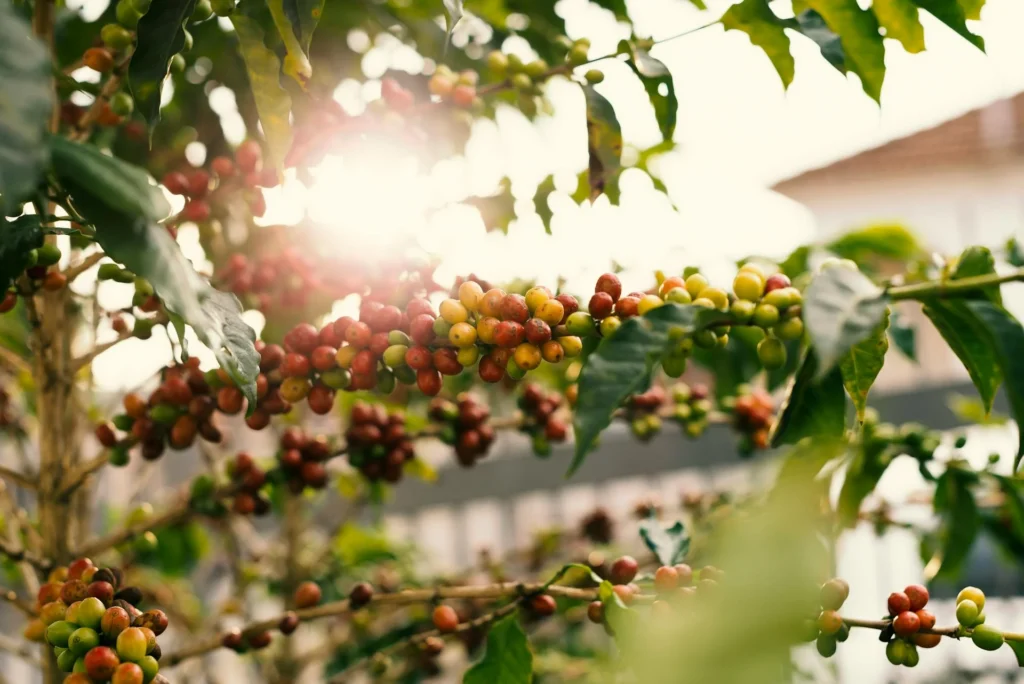Looking for the best machine for lattes? This article highlights the top 10 latte machines for 2024, detailing their key features to help you make the perfect choice.
Key Takeaways
When choosing a latte machine, consider features like built-in grinders, efficient milk frothers, and precise temperature control to enhance your coffee experience.
Investing in a latte machine at home can save money, provide convenience, and allow for personalization of your coffee drinks, transforming brewing into a delightful hobby.
The best latte machines include both semi-automatic options for hands-on brewing and fully automatic machines for quick, café-quality drinks at home.
Top Latte Machines at a Glance
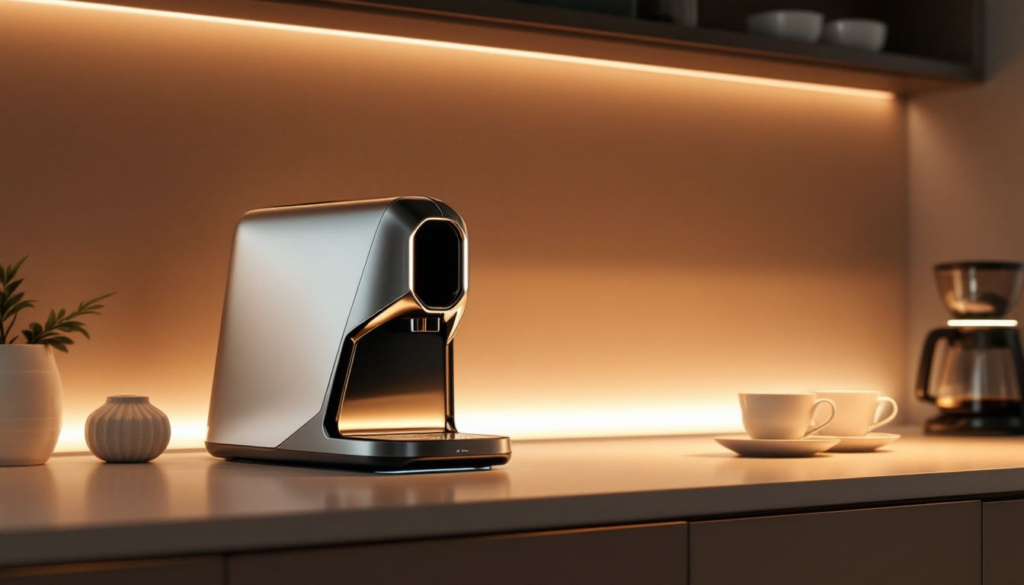
With numerous options, selecting the perfect latte machine can be challenging. Here’s a quick overview of some top latte machines of 2024, known for their intuitive interfaces and standout features.
The Philips 3200 Series LatteGo features a touchscreen that simplifies operation and can brew five different coffee drinks, making it versatile. The Keurig K-Cafe includes a user-friendly frother with settings for cold, latte, and cappuccino. The Breville Bambino Plus heats up in less than five seconds and can brew a latte in under two minutes, perfect for those short on time.
Machines like the Hamilton Beach Espresso Maker and Nespresso by De’Longhi Lattissima Touch offer manual control for steam frothing and a customizable milk frothing dial, respectively. The De’Longhi La Specialista features a built-in grinder that measures coffee grounds precisely for optimal brewing. These features make these machines some of the best available, catering to various tastes and preferences.
A larger water reservoir in a latte machine reduces the need for frequent refills, enhancing convenience. Many top machines also feature compact designs, fitting seamlessly into any kitchen setup.
These machines make brewing espresso and creating delicious lattes at home easier than ever with the best espresso machine, an espresso shot, automatic espresso machines, and traditional espresso machines.
Why Invest in a Latte Machine?

If you’re a regular at your local coffee shop, you might be surprised at the savings you can achieve by brewing lattes at home. Frequent trips to the café can add up, and an espresso machine can pay for itself in no time. Beyond the financial aspect, having a latte machine at home offers unparalleled convenience. No more waiting in line or rushing out in the morning; you can brew espresso and enjoy your favorite coffee drink right in your kitchen.
Owning a latte machine provides precise control over brewing variables like grind size, temperature, and pressure, enhancing coffee flavor. This control is often not available with most coffee shop machines. Super-automatic machines brew drinks at the touch of a button, automating milk steaming and ensuring consistent results.
A personal latte machine allows for creative experimentation with flavors, coffee beans, and latte macchiato art, transforming coffee-making from a mundane task into a delightful hobby.
Investing in a latte machine also promotes environmental sustainability by reducing the use of disposable coffee cups and accessories.
Whether you’re an espresso aficionado or someone who appreciates a good caffe latte, a latte machine is a worthwhile investment. It elevates your coffee experience and allows you to enjoy a delicious latte at home whenever you want.
Best Semi-Automatic Latte Machines
Semi-automatic latte machines are favored by coffee aficionados who enjoy the art of brewing espresso. These machines offer the most control over the coffee-making process, allowing users to pack the portafilter and decide when to stop brewing. This hands-on approach can be messier and more time-consuming than using automatic machines, but the reward is a customized brew.
The reward is a delicious latte made to your specifications. Top semi-automatic latte machines include the Breville Barista Pro, Rancilio Silvia, and Gaggia Classic Pro. Each machine offers unique features catering to different preferences and skill levels, making them excellent choices for home baristas.
Breville Barista Pro

The Breville Barista Pro is a top-rated semi-automatic latte machine, known for its user-friendly features and excellent performance. It features a built-in grinder, ensuring freshly ground coffee for each brew. This grinder is a game-changer for those who value fresh coffee beans for the best espresso quality.
Its steam wand allows users to froth milk to their desired texture, offering control over the microfoam quality. Whether you prefer thick, creamy foam for cappuccinos or a silky smooth texture for lattes, the steam wand delivers.
The machine’s intuitive interface simplifies navigation and customization of your coffee. The combination of the user-friendly interface, built-in grinder, and manual steaming capabilities makes the Breville Barista Pro a versatile tool for latte enthusiasts.
In summary, the Breville Barista Pro provides a perfect blend of convenience and control, making it ideal for those who enjoy the art of coffee making. Its features ensure you can brew a delicious latte with freshly ground coffee beans at home.

Rancillio Silvia
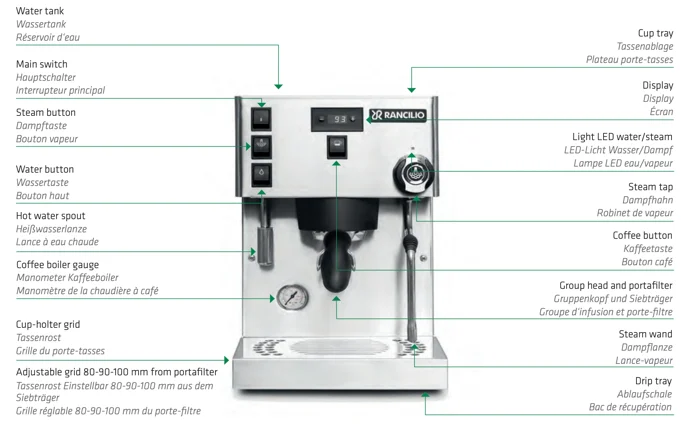
The Rancilio Silvia is renowned for its durable build and commercial-grade parts. As a single boiler machine, it offers a powerful manual steam wand that uses full boiler pressurizing steam, allowing for superior milk frothing and texturing. This makes it a favorite among espresso aficionados who value quality and precision.
Despite its traditional design, the Rancilio Silvia offers high control over the brewing process, allowing users to craft coffee drinks to perfection. Its robust construction ensures longevity, making it a reliable investment for serious home baristas.
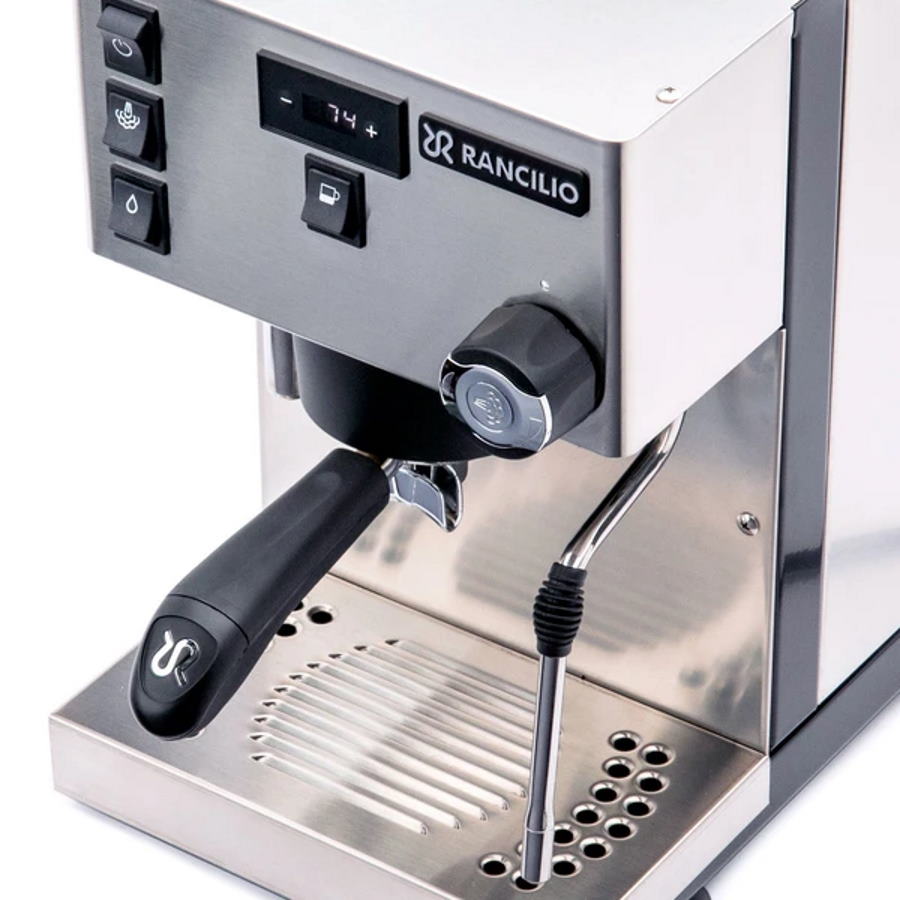
Gaggia Classic Pro

The Gaggia Classic Pro is popular among home espresso enthusiasts for its commercial-grade components and reliable performance. This single boiler machine features durable parts that ensure long-term use, providing excellent value for money.
A key feature of the Gaggia Classic Pro is its powerful steam wand, enabling excellent milk frothing and texturing. Combined with its robust build, the Gaggia Classic Pro is ideal for those who want to brew high-quality espresso and create delicious lattes at home.
Best Fully Automatic Latte Machines

Fully automatic latte machines offer a hassle-free coffee-making experience, handling the entire process from grinding beans to frothing milk at the press of a button. This convenience is ideal for busy individuals who want to enjoy a delicious latte at home.
Top fully automatic latte machines include the Jura E8, Philips 3200 Series LatteGo, and DeLonghi Dinamica Plus. These machines feature advanced technology that ensures consistent quality and flavor, preparing a variety of coffee drinks like lattes, cappuccinos, and espressos with rich flavor notes such as chocolate, hazelnut, and caramel.
Jura E8

The Jura E8 is a standout fully automatic espresso machine with the Aroma G3 grinder, known for its speed and consistency. It can brew 17 types of coffee beverages effortlessly, matching professional coffee shop quality. The P.A.G.2 grinder ensures fresh coffee grounds for each brew, enhancing flavor.
Its 3.5-inch push-button display is user-friendly, making coffee selection straightforward. The Jura E8 also uses advanced brewing technology to optimize the extraction process, ensuring each cup is brewed to perfection. This combination of features makes the Jura E8 ideal for those seeking convenience and quality.
Philips 3200 Series LatteGo

The Philips 3200 Series LatteGo is another excellent fully automatic latte machine, featuring a ceramic burr grinder for even grinding and aroma preservation. Testers note that drinks from this machine are flavorful but tend to be lighter in body and not as hot as some might prefer.
A standout feature of the Philips 3200 Series LatteGo is its compact design, suitable for small kitchens. Despite its size, it delivers reliable performance and a variety of coffee drinks, making it a versatile addition to any home coffee setup.
DeLonghi Dinamica Plus

The DeLonghi Dinamica Plus offers a high-end coffee-making experience with its color touchscreen display and stainless steel conical burr grinder. It features an automatic milk frother that produces microfoam, perfect for lattes and cappuccinos, and offers a direct latte option through its controls, enhancing convenience.
A unique feature of the DeLonghi Dinamica Plus is its remote control capability through the Coffee Link app, allowing users to prepare coffee drinks from a distance. This combination of advanced features and user-friendly design makes it ideal for those seeking a seamless coffee-making experience.
Key Features to Look for in a Latte Machine
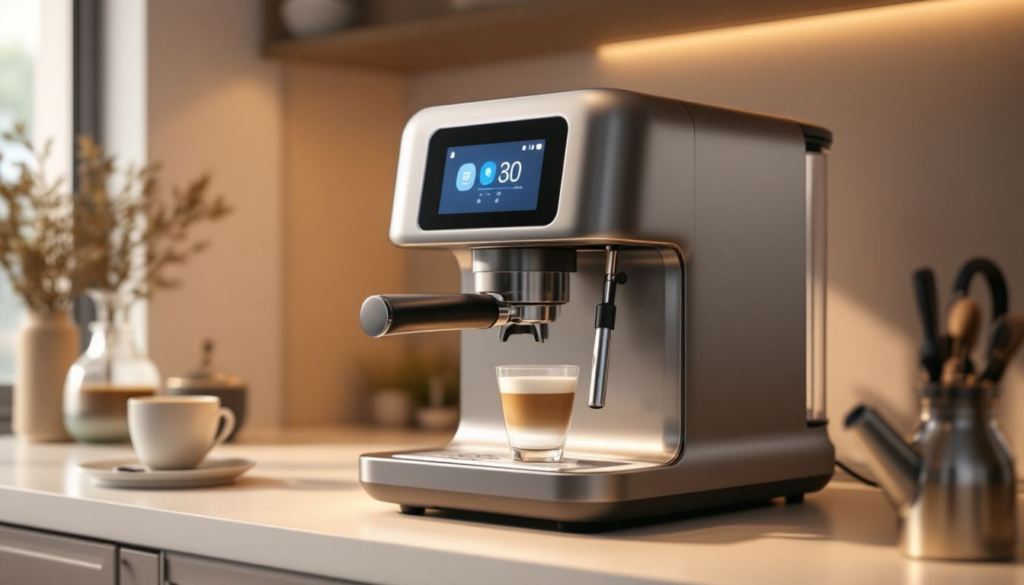
When choosing a latte machine, several key features can significantly enhance your coffee-making experience. A built-in grinder, an efficient milk frothing system, and precise temperature and pressure control are crucial for high-quality lattes.
Each feature plays a unique role in ensuring you brew espresso with the best flavor and texture. Here’s a closer look at these aspects and their importance when selecting the best latte coffee machine for your needs.
Built-In Grinder

A built-in grinder is a valued feature in many latte machines, providing the convenience of grinding coffee beans on demand. This ensures freshly ground coffee beans, significantly enhancing the flavor and aroma of your espresso. Machines like the Breville Barista Pro are equipped with such grinders, seamlessly integrating fresh coffee into your brewing process.
While standalone grinders are generally more versatile with more grind size options, the convenience of a built-in grinder cannot be overstated. It saves counter space and simplifies the coffee-making process, especially for those who prefer a quick setup.
Ultimately, whether you choose a machine with a built-in grinder or opt for a separate grinder, the goal is to ensure that your coffee grounds are fresh and finely ground to achieve the best espresso quality.
Milk Frothing System

The milk frothing system is another critical feature to consider when selecting a latte machine. There are various types of frother and steamer devices available, including built-in steam wands, as well as separate manual, handheld, and electric devices. Each type has its advantages and drawbacks, depending on your needs and preferences.
Manual and handheld frothers are typically smaller and less powerful but can be a cost-effective option for those who don’t mind a bit of extra effort. On the other hand, electric frothers and built-in steam wands in advanced machines offer superior texture and consistency, creating café-quality drinks with minimal hassle.
The quality of the milk foam is crucial for a delicious latte. Silky, fine-textured milk foam enhances both the flavor and visual presentation of your drink. The combination of powerful steaming and the right frothing technique can elevate your latte to café standards, making this feature a vital consideration.
Temperature and Pressure Control

Maintaining the right temperature and pressure is essential for brewing a high-quality espresso. The optimal brewing temperature typically ranges between 195°F and 204°F, and brewing coffee with water below this range can lead to under-extracted and sour coffee. Ensuring consistent temperature control can make a significant difference in the taste of your espresso.
High pressure, generally around nine bars, is necessary for effective espresso extraction. This pressure helps in regulating the extraction process and flavor concentration, which impacts the overall taste of the espresso. Many advanced espresso machines come equipped with a PID controller to manage brew temperatures accurately, ensuring consistent and perfect espresso shots every time.
By paying attention to these key features, you can make an informed decision and choose a latte machine that meets your needs and delivers outstanding coffee quality.
Choosing the Right Coffee Beans for Your Latte Machine

The quality of your latte greatly depends on the coffee beans you use. Freshness is paramount, so always check for a roast date to ensure the beans are at their peak flavor. Freshly roasted coffee beans can transform an average cup of coffee into a delightful experience.
Arabica beans are typically smoother and sweeter, making them a popular choice for lattes, while Robusta beans are stronger and more bitter. A blend of Arabica and Robusta can create a balanced flavor profile that many coffee drinkers find appealing. Additionally, the origin of the beans plays a significant role in their flavor; for example, Ethiopian beans are known for their fruity notes, while Colombian beans often have a nutty profile.
The roast level is another crucial factor. Light roasts tend to have bright and acidic flavors, while dark roasts offer a bold and rich taste. For lattes, a medium to dark roast is usually preferred as it provides a robust flavor that pairs well with milk.
The grind size is also important; finer grind sizes are recommended for espresso to enhance the overall quality of the latte. Experimenting with different types of coffee beans can help you discover your personal preferences. High acidity can brighten flavors, while a full-bodied coffee can provide a rich, creamy feel. Some beans even have natural sweetness, which can balance out the bitterness, making your lattes more enjoyable.
How to Properly Steam Milk for Lattes

Steaming milk properly is an art that can elevate your latte to new heights. To start, use cold milk and pour it into a metal pitcher, ensuring the steam wand is just below the surface of the milk. Engaging the steam output creates a steady stream of steam. Positioning the wand near the side of the pitcher helps generate a vortex, which is essential for creating the right texture.
Incorporate air into the milk by gently moving the pitcher up and down around the steam wand. This technique helps reduce bubble size and creates a smooth, velvety texture. Aim to stop steaming once the milk has increased in volume by 1.5 times if you’re making a latte or doubled for a cappuccino.
After steaming, tap the pitcher against a countertop to pop any larger bubbles and swirl the milk to enhance its texture. This step ensures that the milk is evenly textured and ready for pouring.
Finally, always clean the steam wand immediately after use to prevent milk residue buildup and ensure hygiene. Properly steamed milk can significantly improve the taste and presentation of your lattes, making them a treat to enjoy.
Maintenance and Cleaning Tips for Latte Machines
Maintaining your latte machine is crucial for ensuring its longevity and performance. Regular descaling is essential to prevent clogging, altered coffee taste, or overheating. Using filtered or softened water can help reduce scale buildup, extending the life of your machine.
Daily maintenance tasks should include purging the steam wand and group head to remove milk and coffee residue. This practice helps maintain the machine’s hygiene and ensures consistent performance. For a more thorough clean, use a suitable cleaning solution every 2-4 weeks to clean the machine’s components.
Grinders should also be cleaned every six months to maintain optimal performance and flavor. Regular maintenance and cleaning not only enhance the taste of your coffee but also ensure that your espresso machine operates smoothly for years to come. By following these tips, you can enjoy delicious lattes and other coffee drinks without any hiccups.
Summary
Investing in a latte machine can revolutionize your coffee experience at home. From the convenience of brewing your favorite coffee drinks to the financial savings and environmental benefits, the advantages are clear. Whether you prefer a semi-automatic machine for greater control or a fully automatic one for ease of use, there’s a perfect latte machine out there for you.
Key features like a built-in grinder, efficient milk frothing system, and precise temperature and pressure control are essential for brewing high-quality espresso. Choosing the right coffee beans and learning how to steam milk properly can further enhance your lattes, making them a delight to enjoy.
In conclusion, by understanding the different types of machines and their features, you can make an informed decision that suits your needs. Whether you’re a seasoned barista or a latte lover, the right latte machine can bring the café experience to your kitchen, making every cup of coffee a special treat.
Frequently Asked Questions
What are the key differences between semi-automatic and fully automatic latte machines?
The key difference is that semi-automatic machines give you control over brewing time and process, while fully automatic machines take care of everything with just one button. So, if you prefer hands-on brewing, go semi-automatic; if you want convenience, choose fully automatic.
How often should I clean and maintain my latte machine?
You should aim to descale your latte machine monthly and clean its components every 2-4 weeks for optimal performance. Don’t forget to purge the steam wand and group head daily, and give your grinder a thorough clean every six months!
What type of coffee beans are best for lattes?
For the best lattes, go for freshly roasted Arabica beans, which offer a smooth and sweet flavor. A medium to dark roast gives a rich taste that complements the milk perfectly.
How do I properly steam milk for a latte?
To properly steam milk for a latte, use cold milk in a metal pitcher. Insert the steam wand just below the surface and create a vortex by positioning it near the pitcher’s side. Stop steaming when the milk expands by 1.5 times, then tap and swirl to improve the texture.
What are the benefits of a built-in grinder in a latte machine?
A built-in grinder ensures you get freshly ground coffee every time, which boosts the flavor and aroma of your espresso. That means a richer, more delicious latte for you!
What Features Should I Look for in the Best Latte Machine?
The best latte machine should have a milk frother to create creamy, textured frothed milk for your lattes. Look for machines with a built-in burr grinder for freshly ground coffee, as it enhances the flavor of your espresso shot. Models like super automatic espresso machines are great for convenience, allowing you to make specialty drinkslike lattes and cappuccinos with ease.
If you enjoy versatility, some machines also brew drip coffee, making them ideal for households with diverse coffee preferences.
Can Espresso Machines Be Used for Lattes?
Yes, most espresso machines are perfect for making lattes. You’ll need an espresso maker that can pull a rich double espresso shot and has a steam wand or milk frother to prepare the milk. Many super automatic machines can handle this process automatically, but even manual machines let you steam milk manually for full control over the texture.
How Do I Create Latte Art with a Machine?
To pour latte art, use a machine with a high-quality steam wand for microfoam. Steam milk until you achieve silky frothed milk, then carefully pour it over your espresso shot. The key is smooth, textured milk that blends easily with the espresso.
Can Latte Machines Brew Drip Coffee?
Some latte-focused coffee machines can also brew drip coffee, offering versatility for households where not everyone prefers lattes. These machines combine the richness of an espresso shot with the simplicity of hot coffee for a variety of options.
What’s the Difference Between Latte Machines and Cappuccino Machines?
A cappuccino machine typically emphasizes frothy milk with equal parts foam, milk, and espresso. In contrast, latte machines prioritize more milk for a creamier texture, making them ideal for latte drinkers. Both use similar components like a steam wand or milk frother.
Can I Use Oat Milk for Lattes?
Yes, oat milk is a popular alternative for lattes and works well with most espresso machines. Its natural creaminess creates excellent microfoam for both lattes and latte macchiato drinks.
What’s the Role of the Drip Tray in Espresso Machines?
The drip tray collects excess liquid during brewing and steaming. It’s a key feature for keeping your workspace clean, especially when making espresso drinks like lattes.
Are Commercial Machines Necessary for Good Lattes?
Not necessarily. While commercial machines offer powerful features for high-volume use, many home-focused espresso makers deliver equally great results for lattes. Compact semiautomatic machines or super automatic machines can replicate café-quality drinks at home.
What’s a Good Coffee Grinder for Latte Machines?
A good coffee grinder ensures your espresso grounds are consistent, enhancing the flavor of your latte. Some machines come with a built-in burr grinder, saving counter space and ensuring freshly ground coffee for every cup.
Can Latte Machines Make Iced Coffee?
Yes, you can use your latte machine to prepare iced coffee by brewing an espresso shot over ice and adding chilled milk or foam. It’s a refreshing alternative to traditional hot coffee.
What is the Best Coffee Gear for Latte Drinkers?
Essential coffee gear includes an espresso maker, a milk frother, and a reliable grinder. Accessories like a tamper, drip tray, and milk pitcher also improve the latte-making experience.
What Makes Espresso Tastes So Rich in Lattes?
Lattes use concentrated espresso shots, which deliver bold flavors that blend seamlessly with milk. The combination of rich coffee and steamed milk creates a creamy, flavorful drink perfect for any time of day.


